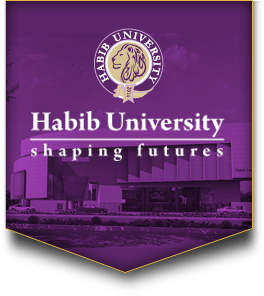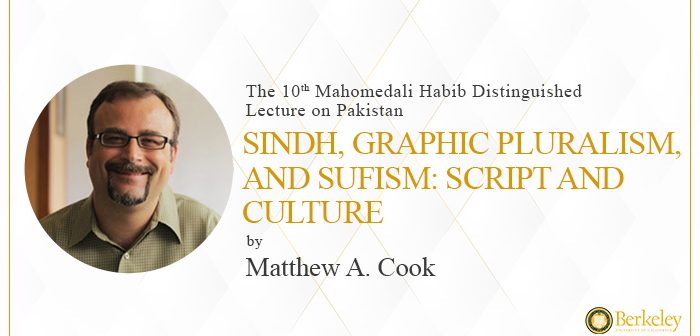The 10th Mahomedali Habib Distinguished Lecture on Pakistan was hosted by the Institute for South Asia Studies at UC Berkeley as part of the Berkeley Pakistan Initiative on December 02, 2022. The lecture, titled, “Sindh, Graphic Pluralism and Sufism: Script and Culture” was delivered by Dr. Matthew A. Cook, Professor of South Asian and Post-Colonial Studies at North Carolina Central University.
The lecture series is named to pay tribute to the inimitable generosity of Mahomedali Habib, the one who laid the foundation for House of Habib. His devotion to reorient philanthropy in Pakistan towards the noble cause of education resulted in the historic establishment of Pakistan’s first community owned and Liberal Arts and Sciences Institution, Habib University.
Dr. Matthew has held several academic positions as he currently teaches in North Carolina Central University, and he has also been affiliated with Michigan State University, Duke University, New York University, and several others. Moreover, his core areas of teaching and research are South Asian Cultures and History, Languages and Literature, Linguistic Anthropology and Social Inequality.
This work of Matthew A. Cook was initially part of his dissertation. In the first place, he wanted to work on the Sindhi writing system. However, he later changed his mind and added a few things to it. This presentation focused on the 1856 British declaration on the Sindhi writing script. Before this, Sindhis used to write their language in distinctive styles. This presentation derived its material from different walks of life such as linguistics, history, and anthropology to question how language underwrote the colonial experience.
At the 10th 10th Mahomedali Habib Distinguished Lecture, he argued that developing an Arabic-style script by the Imperialists for the Sindhis developed a core importance for Sufism in Sindhi society and culture. The presentation was divided into two parts. The first part was about the history and anthropology of the Sindhi script and the second part was deductive which dealt with the interpretation of the first part.
He abruptly began by saying that the origin of the Sindhi script had nothing to do with the Mohenjo-Daro and so goes for the language. In 1846 the newly established Karachi Free School Debate wrote a letter to the Board of Education Bombay asking them to establish a vernacular educational curriculum. However, they claimed that they had not enough qualified people to perform that job.
Later, Captain Hebbert of Karachi Free School Debate wrote to George Stack the Deputy Collector of Hyderabad about the problem of Script. Stack was one of the earliest writers who had written about the grammar of colonial languages. Their discussion followed with Sindhi as the national language and Khudabadi script as the best suitable script for the Sindhi language, however, if it was not possible, Gujarati script was better. Stack further added that the script which he was suggesting was used only by the merchants. Lastly, he organized a chart in which he outlined the scripts which were being used to write the Sindhi language.
Francis Burton another Briton deliberatively disagreed with the ideas of Stacks. Burton came out supporting the Naskh i.e., Arabic script. He presented his compelling arguments regarding the usage of the Naskh script. Major Stocks claimed that Stacks was supporting the “Hindu” script, however, Burton was supporting the “Muslim” script.
Sindh’s Secretary sent the documents or the critique of Burton on Stacks to Stacks and did not circulate it. Stack closed the file without answering it. Thus, the file went to other officers for further debate. When the documents for language were sent to the governor of Bombay, he suggested that the language of the people should be used, and that was Sindhi.
Stacks came back and he immediately appointed the officer again. However, he soon died. But Burton never came back. Ella states, “this English-Sindhi dictionary was the reason for the death of Major Stacks.” Language killed him. His extensive work on language took his life.
There followed the Script debate.
Cook claimed that being the best script, Khudabadi was not chosen as the official script because of the shift of interest of the Company from Lohanas to Amils. These both are groups of the Sindhi Hindu community.
Sindh was the death trap for the East India Company. They destroyed Hyderabad. They auctioned the material goods of Sindhi rulers. They wanted Sindh to sustain and pay as it was their basic motive.
There was a problem with the Khudabadi script. It was not spoken by a bunch of people but by merchants and the region of Khudabad only. On the contrary, the Government had to facilitate its officers. As the officers already knew Persian and it was nearer to Naskh script.
Later he spoke on the next part of the discussion, the interpretation. He told about the importance of Burton’s arguments by giving its two characteristics.
- Naskh
- Sufism
He further added, about the Sindhi culture and its historical importance which was rooted in the socio-economic conditions of that time.
He talked about the different tribes and castes which had dwelled on the land. Most notably he talked about the Sindhi Baloch, Sindhi Pathans, and Lower-caste Hindus. Burton’s chart mentioned the different dialects. Burton’s written documents show the hate for Hindus and the colonial interpretation of the South Asian region.
Finally, he related the idea of Fractal Recursivity with the works of Burton at the 10th Mahomedali Habib Distinguished Lecture. Through the colonial Fractal Recursivity and a racial touch, the Sufism from mid-nineteenth century flourished in Sindh. Even the “Shah Jo Risalo” was originally written in Naskh script.




